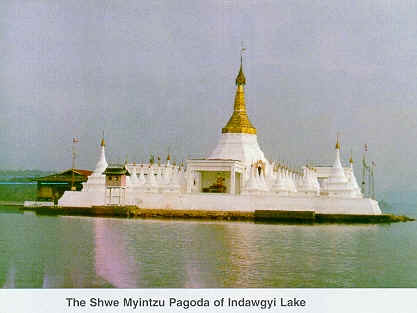
Pagodas and Legends
By Ba Than
Myanmar Perspectives
Vol: VI 1/2001

Pagodas are indeed unique landmarks of Myanmar. In no other country can you find such manifestation of devotion demonstrated by Myanmar Buddhists to Buddhism. Verily no hill is so high, no valley so deep, no forest so dense, no plain barren as to prevent a pious Buddhist to build a pagoda of glittering gold or snow-white coat, no matter how large or small, for no work of merit is believed to be so richly rewarded as building and donating a pagoda for the propagation of Buddhist faith. A writer noted that a group of trekkers scaled Mt Victoria, reputed to be the third highest peak (10,000 ft), and was surprised to find a pagoda already there, the region they least expected to witness such a feat of devotion considering the immense height and intensity of work to accomplish such a wonder.
History has recorded that Myanmar enjoyed prosperity as early as the Bagan Dynasty, principally during the reigns of the first Myanmar Emperor King Anawratha (1044-1077) and King Kyansittha (1084-1112), popularly known as Bagan Golden Age. It also witnessed another gold, i.e. the golden age of pagoda building. In that age of rote, where Myanmar and Pali literature was preserved to memory by word of mouth, rhyme or verse is the easiest way to remember things by. Thus the number of Bagan pagodas in the 42 square Kilometers of land was recorded in rhyming couplets. Where each ward represented a digit the first four words were meant to be reckoned as 4446. But the common legend extended to seven digits inflating the numbers to millions. Thus it is not surprising that an unsuspecting compiler of Myanmar Guide or coffee table book taking the word from the untutored local Samaritan had dubbed Bagan as "the city of four million pagodas." The invantory of Bagon pagodas researched and recorded by the Myanmar Archeology Department posted the number as 2217.
That was just but one area of the country. Another city which reached the golden era through maritime trade around 16th century was the city of Mrauk-U in Rakhine State. Imposing pagoda of 80,000 Buddha images, Koe-Thaung Pagoda the pagoda of 90,000 images, the Mahamuni of Kyauk Taw are also sacred depositories of Buddhist faith. I believe no pagoda can surpass Moe-Hnyin Pagoda of Monywa where 512,028 Buddha images repose.

The most well-known and revered landmark is naturally the Shwe Dagon, one of the wonders of the world. Other no less revered pagodas are Golden Rock (Kyaik Hti Yoe) of Kyaithto, the gold laden Maha Muni image of Mandalay, the Five Golden Image of Inle Phaung Daw Oo, and the sacred Sagaing Hills, refuge of the holy monks and nuns.
Lord Buddha's last instructions to his disciple Ashin Ananda included permission to build and revere shrines, pagodas as places of worship. Thus many pagodas and images were built through the centuries as the most sublime forms of meritorious deeds. In the course of years, many legends grew, attributable to certain pagodas, heightening devotion and obeisance or increasing the aura and omnipotence, in the belief that prayers and wishes will be answered. Naturally these legends passed through the generations by word of mouth, difficult to authenticate, or too different to challenge for fear of incurring the wrath of the guardian spirits. Some of the well worn legends which may exite the inquring minds are presented herein.
